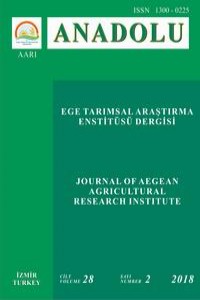Abstract
ÖZ: Bu çalışma, Akkaya gölünü besleyen ve aşırı
kirletilmiş Niğde deresindeki aşırı kirlenmenin önlenmesi ve biyoçeşitliliğin
korunumunu amaçlamaktadır. Bu sebeple, pilot-ölçekli karma bir doğal atıksu
arıtma (DAA) sistemi 2014 yılında derenin yakın kenarında inşa edilmiştir.
Sistem sırayla çökeltme havuzu (ÇH), serbest yüzey akışlı yapay sulakalan
(SYA-YS) ve arazi üzerinden akışlı (AÜA) bir yataktan oluşmuş ve derenin
kirletilmiş suları ile beslenmiştir. Su örnekleri; sıcaklık, pH, çözünmüş
oksijen (ÇO) ve biyokimyasal oksijen ihtiyacı (BOİ) analizleri için dereden ve
gölden seçilen 6 farklı istasyondan ve arıtma sisteminin giriş ve çıkışlarından
alınmıştır. Çalışma sonuçlarına göre, dere ve göldeki BOİ konsantrasyonları
işletme periyodu süresince önemli değişiklikler göstermiştir. Göldeki BOİ
konsantrasyonu mevsimsel değişmelerden fazla etkilenmezken deredeki BOİ
konsantrasyonları sıcak mevsimlerde daha yüksek bulunmuştur. Çalışma sonuçları,
derenin yüksek organik madde girişinden dolayı aşırı derecede kirletildiğini ve
gölün ötrofik hale geçtiğini göstermiştir. Yüksek organik madde yüküne rağmen
arıtma sistemi yaklaşık olarak %83 BOİ giderme verimi sağlamıştır. Sonuçlar,
arıtma sisteminin dere ekosisteminin rehabilitasyonu ve böylece su kalitesinin
iyileştirilmesi için çok faydalı bir uygulama olabileceğini göstermiştir.
Keywords
Arazi üzerinde akışlı sistem biyoçeşitliliğin korunumu yapay sulakalan sistemi doğal atıksu arıtma sistemi.
References
- Anonymous. 1999. Metropolitan Waterworks Authority.
- https://www.mwa.co.th/download/file_upload/SMWW_1000-3000.pdf.
- Anonymous. 2000. EPA. United States Environmental Protection Agency. Wastewater technology fact sheet free: water surface wetlandshttps://www3.epa.gov/ npdes/pubs/free_ water_surface_wetlands.pdf.
- Anonymous. 2002. EPA. United States Environmental Protection Agency. Implementation guidance for ambient water quality criteria for bacteria. https://nepis.epa.gov/Exe/tiff2png.cgi/20003PSB.PNG?-r+75+-g+7+D%3A%5CZYFILES%5CINDEX%20DATA%5C00THRU05%5CTIFF%5C00000486%5C20003PSB.TIF.
- Anonymous. 2004. Su Kirliliği Kontrol Yönetmeliği. Resmi Gazete. From: http: // www.resmigazete.gov.tr /eskiler /2004/12/20041231.htm#9.
- Anonymous. 2006. TETRA TECH-Environmental Management. http://www.tetratech.com/en/environmental-management.
- Anonymous. 2009. Su Kirliliği Kontrol Yönetmeliği-Remi Gazete: Numune alma ve analiz metodları. From: https://www.csb.gov.tr/db/cygm/editordosya/.
- Anonymous. 2014. Türkiye Hava Durumu. From: http://www.accuweather.com/tr/tr/nigde/319795/january-weather/319795?monyr=1/1/2015&view=table.
- Boyd, C. E. 1990. Water Quality in Ponds for Aquaculture. Birmingham Publishing Company, Birmingham, Alabama.
- Crites, R. W., Reed, S. C., and R. K. Bastian. 2004. Land Treatment Systems for Municipal and Industrial Wastes, McGraw-Hill Companies, USA.
- Crites, R. W., and G. Tchobanoglous. 1998. Small and Decentralized Wastewater Management Systems, McGraw-Hill, New York, NY.
- Kadlec, R. H., and S. D. Wallace. 2009. Treatment Wetlands, Second Ed., CRC Press, Boca Raton, FL USA.
- Tuncsiper, B. 2016. The treatment of the Kızılca creek that pollutes the Akkaya reservoir by natural wastewater treatment method, TUBITAK. Project Number. 113Y589, 2014-2016.
- Tuncsiper, B. 2017. Investigation of bacteriological contamination in Kızılca (Karasu) Creek feeding Akkaya reservoir and solution proposals to reduce contamination. Journal of Tekirdağ Agricultural Faculty. 14 (1): 28-37.
- Wen, C. G., Chen, T. H., Hsu, F. H., Lu, C. H., Lin, J. B., Chang, C. H., Chang, S. P., and C. S. Lee. 2007. A high loading overland flow system: Impact on soil characteristics, grass constituents, yields and nutrient removal. Chemosphere 67: 1588-600.
Abstract
ABSTRACT: This study aims to prevent excessive pollution and conservation of biodiversity in over-polluted Niğde Creek feeding Akkaya lake. Therefore, a pilot-scale hybrid natural wastewater treatment (NWT) system was constructed at edge of the stream in 2014. The system consisted of settling basin (SB), followed by a free water surface constructed wetland (FWS-CW) and overland flow (OF) bed was fed with contaminated waters of creek. Water samples were collected for temperature, pH, dissolved oxygen (DO), and biochemical oxygen demand (BOD) analysis from 6 different stations chosen in the creek and the lake, and the inputs and outputs of the system. According to the study results, the BOD concentrations in the creek and lake showed significant changes during operation period. While the BOD concentration in the lake was not much affected by the seasonal changes, the BOD concentrations in the creek were higher in the warmer seasons. The study results indicated that the creek was over-polluted due to high organic matter input, and lake became eutrophic. Despite the high organic matter load, the treatment system dramatically reduced the average BOD from 471 mg l-1 up to an average of 88 mg l-1. The results indicated that the treatment system might be a very successful treatment application for rehabilitation of the creek ecosystem and thus the improvement of the water quality.
Keywords
Overland flow system conservation of biodiversity constructed wetland system natural wastewater treatment.
References
- Anonymous. 1999. Metropolitan Waterworks Authority.
- https://www.mwa.co.th/download/file_upload/SMWW_1000-3000.pdf.
- Anonymous. 2000. EPA. United States Environmental Protection Agency. Wastewater technology fact sheet free: water surface wetlandshttps://www3.epa.gov/ npdes/pubs/free_ water_surface_wetlands.pdf.
- Anonymous. 2002. EPA. United States Environmental Protection Agency. Implementation guidance for ambient water quality criteria for bacteria. https://nepis.epa.gov/Exe/tiff2png.cgi/20003PSB.PNG?-r+75+-g+7+D%3A%5CZYFILES%5CINDEX%20DATA%5C00THRU05%5CTIFF%5C00000486%5C20003PSB.TIF.
- Anonymous. 2004. Su Kirliliği Kontrol Yönetmeliği. Resmi Gazete. From: http: // www.resmigazete.gov.tr /eskiler /2004/12/20041231.htm#9.
- Anonymous. 2006. TETRA TECH-Environmental Management. http://www.tetratech.com/en/environmental-management.
- Anonymous. 2009. Su Kirliliği Kontrol Yönetmeliği-Remi Gazete: Numune alma ve analiz metodları. From: https://www.csb.gov.tr/db/cygm/editordosya/.
- Anonymous. 2014. Türkiye Hava Durumu. From: http://www.accuweather.com/tr/tr/nigde/319795/january-weather/319795?monyr=1/1/2015&view=table.
- Boyd, C. E. 1990. Water Quality in Ponds for Aquaculture. Birmingham Publishing Company, Birmingham, Alabama.
- Crites, R. W., Reed, S. C., and R. K. Bastian. 2004. Land Treatment Systems for Municipal and Industrial Wastes, McGraw-Hill Companies, USA.
- Crites, R. W., and G. Tchobanoglous. 1998. Small and Decentralized Wastewater Management Systems, McGraw-Hill, New York, NY.
- Kadlec, R. H., and S. D. Wallace. 2009. Treatment Wetlands, Second Ed., CRC Press, Boca Raton, FL USA.
- Tuncsiper, B. 2016. The treatment of the Kızılca creek that pollutes the Akkaya reservoir by natural wastewater treatment method, TUBITAK. Project Number. 113Y589, 2014-2016.
- Tuncsiper, B. 2017. Investigation of bacteriological contamination in Kızılca (Karasu) Creek feeding Akkaya reservoir and solution proposals to reduce contamination. Journal of Tekirdağ Agricultural Faculty. 14 (1): 28-37.
- Wen, C. G., Chen, T. H., Hsu, F. H., Lu, C. H., Lin, J. B., Chang, C. H., Chang, S. P., and C. S. Lee. 2007. A high loading overland flow system: Impact on soil characteristics, grass constituents, yields and nutrient removal. Chemosphere 67: 1588-600.
Details
| Primary Language | English |
|---|---|
| Journal Section | Makaleler |
| Authors | |
| Publication Date | October 22, 2018 |
| Submission Date | November 21, 2017 |
| Published in Issue | Year 2018 Volume: 28 Issue: 2 |


